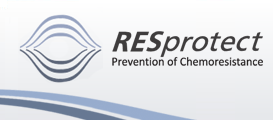|
Page 5 of 12
CGH.
DNA labeling and CGH on normal rat chromosomes obtained from fetal rats were performed as described previously (15). Briefly, equal amounts of digoxigenin- and biotin-labeled genomic DNA from drug-treated and from BVDU + drug-treated tumors, respectively, were hybridized to normal metaphases obtained from fetal rat cells. Hybrid molecules were detected with one layer of avidin-FITC (Sigma, Munich, Germany) and rhodamine-antidigoxigenin Fab fragments (Roche Diagnostics, Mannheim, Germany). Slides were mounted and counterstained with antifade solution containing 1 µg/ml 4,6-diamidino-2-phenylindole and actinomycin D (both Serva, Heidelberg, Germany) and analyzed using a cooled CCD camera (Hamamatsu Photonics, Herrsching, Germany) mounted on a Zeiss Axioskop epifluorescence microscope (Carl Zeiss, Göttingen, Germany). The ISIS Digital Image Analysis System (MetaSystems, Altlussheim, Germany) was used for ratio profile analysis, which was based on >7 well-hybridized metaphases.
Real-Time PCR.
Genomic DNA was isolated from each cell subline at various time points using the DNeasy Tissue kit (Qiagen, Hilden, Germany) in accordance with the manufacturer’s instructions. Real-time PCR was performed using the ABI Prism 7700 Sequence Detection System (Applied Biosystems, Foster City, CA). For the target gene, Dhfr, amplification mixes (30 µl) contained 0.8 ng genomic DNA, 10x SYBR-Green buffer, 200 µM dATP, dCTP, dGTP, and 400 µM dUTP, 3 mM MgCl2, 0.75 units of AmpliTaq Gold, 0.3 units of AmpErase uracil N-glycosylase (Applied Biosystems), and 200 nM of each primer (Thermo Hybaid, Ulm, Germany). For the reference gene,18S rRNA, 10x TaqMan buffer, 5 mM MgCl2, 400 nM of each primer, and 200 nM TaqMan fluorogenic probe (Thermo Hybaid) were used. Thermal cycling consisted of 40 cycles at 95°C for 15 s and 60°C for 1 min, and contained an initial step of 2 min at 50°C and 10 min at 95°C. We prepared a reference calibration curve with stepwise dilutions (1:5) starting with 100 ng genomic DNA. Each 96-well microplate included the standard curve and the sample genomic DNA in triplicate. The normalized Dhfr gene copy number was derived from the ratio of the Dhfr gene copy number to the 18S rRNA reference gene copy number. The amplification of the Dhfr gene was calculated relative to the Dhfr gene copy number of an untreated 3T6 cell line.
Assay of NQO1 Enzyme Activity.
DT-D was assayed as dicoumarol-inhibitable NAD(P)H: dichlorophenolindophenol reductase essentially as described by Hodnick and Sartorelli (16). Equal numbers of exponentially growing AH13r cells were removed from the medium by centrifugation and resuspended in 1 ml of ice-cold PBS. Cells were kept on ice and homogenized twice for 30 s with an Ultra-Turrax T8 homogenizer (IKA, Staufen, Germany). Dicoumarol-sensitive NADPH:2,6-dichloroindophenol (DCPIP) reductase was assayed in a reaction mixture containing 0.05 M potassium phosphate (pH 7.5), 0.3 mM NADPH, 0.04 mM DCPIP, 0.07% BSA, and 0.1 ml of homogenized cells in a final volume of 1 ml. The reaction was initiated by the addition of NADPH, and the rate of DCPIP reduction was determined at a wavelength of 600 nm. Dicoumarol (1 µM final concentration) was then added, and the rate was measured again. The rate of dicoumarol-sensitive NADPH:DCPIP reductase was determined as the difference between the uninhibited and dicoumarol-inhibited rates.
Two-Dimensional Gel Electrophoresis.
AH13r cells were treated for 17 days (36 h recovery for samples 5 and 6) as follows: (a) DMSO (untreated control); (b) BVDU; (c) MMC; (d) MMC + BVDU; (e) recovery after MMC treatment; and (f) recovery with BVDU after MMC + BVDU treatment. Proteins of each group were separated by two-dimensional gel electrophoresis. Differentially expressed proteins were identified by MALDI-MS.
|





